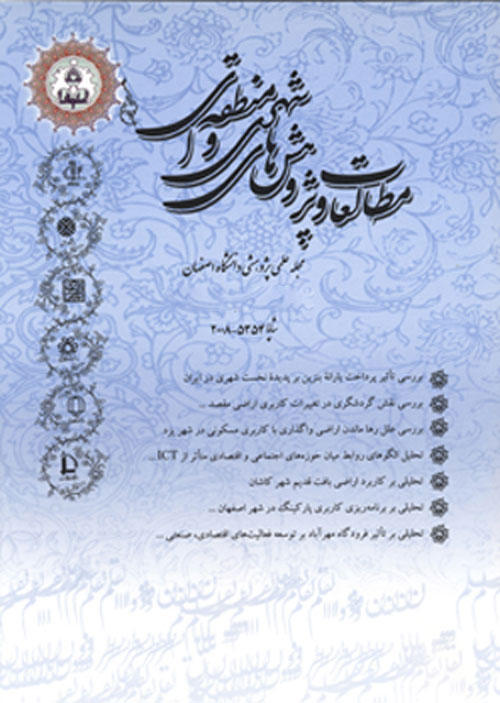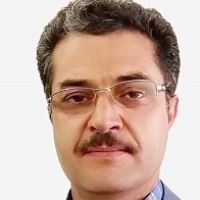Migration, Residential Mobility and Socio-Spatial Structure of Cities (Case study: Sabzevar)
Author(s):
Abstract:
Introduction
Families’ movement from one neighborhood to others neighborhood inside the cities brings up obvious consequences on the formation and changing social domain inside the cities and generally on the social-spatial structure of the cities. In this regard, the entrance of settlers into the city, primary habitation and their movement in the later stages, affects the rate and direction of movements inside the cities to a great extent. Concerning the Iranian cities which are on the one hand still encountered with the wave of immigration from rural areas to urban areas and on the other hand, social-economic changes and lifestyles have made changes in the physical structure and residential patterns, studying why and how residential mobility happens is of particular importance, for accessing the rule of law governing them. Sabzevar is one of Iran intermediate cities and center of Sabzevar Township that located in the Razavi Khorasan Province, where rural migrants constitute about 40% of its population how have migrated to this city over recent decades. The main purpose of this study is to find a reasonable and documented reply to the following basic questions: "in what parts of the city did the rural migrants settle when they first entered this city? How have they changed their place of residence in the next stages? And what elements and variables have affected the process of primary settlement and residential mobility?" The research method is of descriptive and analytical nature and the required data have been gathered through surveying (questionnaire and interview). Theoretical bases: Residential mobility means: movement of the residents of one residential unit in a city to another unit or from a neighborhood to another one in the same city. The residential characteristics of one city or one urban neighborhood are generally developed through localizing behavior or individual decisions or family decisions. Intra -urban movement which covers a wide range of movements made by the family members in various countries can both be voluntar and involuntar. Factors forcing families to change their place of residence in the city, is subject to the desires, ambitions and expectations which in itself it is subject to the family status, education, income, lifestyle and the dweling condition of these families. In addition, physical quality, accessibility to the public services and infrastructure and social identity of various neighborhoods as the attracting and repelling factors play a significant role in the intra urban movements. Discussion
Findings of this study indicate that the migrants, as they arrived at Sabzevar, majorly settled in the marginal regions and occupied the old texture and in terms of the level of income, they resided at the low income district of the city. High percentage of immigrants expresses their motivation to immigrate because of cheap accommodation, lands and rents (52.8 %) and the proximity to the friends and relatives (29.2%). The residential mobility of the migrants in the stages after the primary residence was chiefly in the low and medium income regions and physically it has taken place at the marginal areas of the city. Of course, these movements have usually been started in the positive direction and have not been from low income toward higher income regions but conversely movements to the regions with lower income have also happened. The correlation testes in this research indicate that there is a significant correlation between the variables such as income, education and the migration record of the migrant families and the direction of their intra-urban movements. Conclusion
Social and physical structure of Sabzevar during the few past decades has been affected by a large number of rural immigrants to this city and the primary residence and their movement in the next stages in various areas of the city. Development of the quasi marginal areas in the city margins, spatial development of Tohid Shahr and affecting on the social structure, evacuation of some middle class and upper middle class families from the central texture of the city and their replacement by the rural immigrants can be referred to as the most important effect. The highest volume of inner city movement of the settlers in has been done the areas with medium and low income and the physical areas of the margin and the old texture. Suggestions: In order to control and manage the residential movement and social-spatial outcomes in Sabzevar and also responding to the demands resulting from these movements, particularly in the housing sector in this city, the following suggestions are presented: For determining and changing residential density in the various areas of the city, dominant processes of intra- urban movements, socio- economic- characteristics, motivations and needs of families interested in movement should be considered. In this regard, it is suggested that the density of the areas with middle class and lower middle class income which have the most residential mobility in them be increased, through observing other civil engineering criteria and rules so that it can respond to the demand in these areas. Implementation of renewal and improvement plans in the old texture and granting benefits and financial facilities and tax incentives to the families residing in these texture, can lead to the revival of residential units in the neighborhoods of this texture and the increasment of attractions of residence for groups with different incomes, especially families with upper middle class income. Continuation of the policy of allocating of Tohid Shahr lands for implementing Mehr Housing Project can prevent from unplanned development of cities on the inappropriate pieces of lands on the margin of the city to some extent and respond to the housing demand especially on behalf of low income groups.Keywords:
Language:
Persian
Published:
Journal Urban - Regional Studies and Research, Volume:3 Issue: 12, 2012
Pages:
101 to 118
https://magiran.com/p1018211
مقالات دیگری از این نویسنده (گان)
-
Investigating the spatial distribution of public services and measuring residents' satisfaction with the quality of access to them (Case Study: Torbat Heydarieh city)
Yaghoub Zanganeh *, Fatemeh Shahriar, Mahdi Zanganeh, Rahman Zandi
Arid regions Geographic Studies, -
Reducing the Vulnerability of Vital Arteries to Flood (Case Study: Sabzevar County)
Abolghasem Sanaifard *, Abolghasem Amirahmadi,
Research and Urban Planning,



